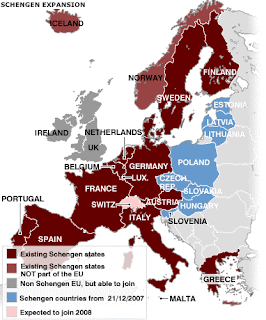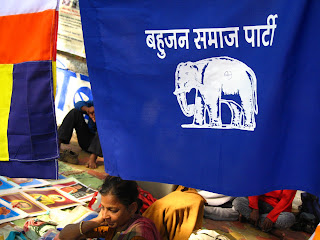 Two dyed-in-the-wool causes are celebrating the inception of Round II. While one of these involves witness intimidation, a murder rate in Baltimore that just topped 300 thus far in 2007, and kids with big guns, the other celebrates expansion of the pan-Euro safety zone and the solidification of a unified European continent.
Two dyed-in-the-wool causes are celebrating the inception of Round II. While one of these involves witness intimidation, a murder rate in Baltimore that just topped 300 thus far in 2007, and kids with big guns, the other celebrates expansion of the pan-Euro safety zone and the solidification of a unified European continent. <(courtesy of BBC)
Stop Snitching in its 2nd avatar is now bigger and badder. The subject matter remains the same, but the stakes have climbed higher, since the original's makers mostly went to jail for crimes related to what they discussed openly in the ghettocumentary. This time around, the Baltimore Police Department ain't even playing no games.
Due to the cultural fallout from the first Stop Snitching, the 5-0 in Baltimore have no intention of ceding any ground to the thugs and/or film-makers, whom most mainstream Baltimorons groups together with the actual criminals, a mistake which may or may not be merely a strategic decision aimed at simplifying the equation.
The unbearable truth for many law-abiding citizens is that there is a culture of cool surrounding the culture of actual thuggery. While there is a diehard core of dealers, sellers, and support staff who actually engage in the urban pharmaceutical business, there is a much larger group of citizens who revere the cultural aura surrounding Stop Snitching but do not actually adhere to its titular mantra.

 As such, the terrain has become rockier for the fans and the foes. While I have not yet purchased the new dvd, which is on sale for 14.95 on select websites, it appears that production values are a bit more high-octane this time around. Judging by the silvery Mac with which the director gracefully toys in the clip above, I would say that the sequel probably outdoes the original in cosmopolitanism, finesse, and perhaps even rawness. "Like Part 1 on steroids," this realer than reality tv material is a much more potent cultural statement than most people understand. Part 2 appears more intellectual and nuanced than the silly original. Or perhaps not everyone agrees that showing footage of kids toting guns and puffing Js is not sophisticated or novel. The director claims he is just holding a mirror up to society. And, for all we know, maybe he does indeed provide an accurate depiction of the double-edged sword that thugs and police loathe and love: snitching!
As such, the terrain has become rockier for the fans and the foes. While I have not yet purchased the new dvd, which is on sale for 14.95 on select websites, it appears that production values are a bit more high-octane this time around. Judging by the silvery Mac with which the director gracefully toys in the clip above, I would say that the sequel probably outdoes the original in cosmopolitanism, finesse, and perhaps even rawness. "Like Part 1 on steroids," this realer than reality tv material is a much more potent cultural statement than most people understand. Part 2 appears more intellectual and nuanced than the silly original. Or perhaps not everyone agrees that showing footage of kids toting guns and puffing Js is not sophisticated or novel. The director claims he is just holding a mirror up to society. And, for all we know, maybe he does indeed provide an accurate depiction of the double-edged sword that thugs and police loathe and love: snitching! If the movie does a satisfactory job of defining snitching, then it might end up defending the cause of snitch prevention. In the first film, Skinny Suge made a concerted effort to talk about the extent of his snitch prevention movement and how he intended to start a foundation to oppose this insidious form of anti-criminal criminality. He swore to exact vengeance on those criminals who used the system as long as they could profit from it, and then turned against that same system once they opportunistically realized a new avenue of snitchery might better suit their tastes. I'm curious whether or not the new ghettocumentary lives up to expectations. I also am uncertain about whether the film will further marginalize the Stop Snitching movement or whether both sides in this cultural battle will become more entrenched to the extent that Stop Snitching becomes immortalized as not just one part of the holistic ghetto philosophy but as the cardinal rule.
Schengen II, on the other hand, celebrates progress, order, and continuity, rather than devolution, chaos, and uncertainty. The new concept of Europe that is embodied by the increasingly porous set of nation-states that comprise the continent continues to define itself in unprecedented ways. While much of the rest of the world is erecting concrete slabs and uber high-tech barriers to border-crossing, Europe has been chugging along on this path to cohesion, cooperation, and convergence. While Europe has its problems (high unemployment, ethnic tensions, and swollen welfare coffers), the European course of development leaves the U.S. (Jah bless) in the dust in certain key areas.
 Perhaps I am just bitter about my country's lack of agreement on environmental and healthcare issues. Maybe I have a naive view of contemporary security imperatives and the often jingoistic tone of American foreign policy, but we are seeing the results of ill-advised policies. The rapidly falling dollar perhaps best demonstrates the current President's various ingenious activities, and expats are more keenly aware of how foreign policy decisions impact the American relationship with the rest of the world in both the financial and cultural domains.
Perhaps I am just bitter about my country's lack of agreement on environmental and healthcare issues. Maybe I have a naive view of contemporary security imperatives and the often jingoistic tone of American foreign policy, but we are seeing the results of ill-advised policies. The rapidly falling dollar perhaps best demonstrates the current President's various ingenious activities, and expats are more keenly aware of how foreign policy decisions impact the American relationship with the rest of the world in both the financial and cultural domains. While I don't want to sound like Michael Moore by praising an undoubtedly positive feature of European life and speaking ill of American phenomena (oh how I love apple pie with American cheese melted on top!), I cannot cease comparing my homeland to our buddies across the Atlantic. The EU is incredible in its ability to solidify this notion of European-ness. Although the folks in Brussels need to work out lots of Constitutional issues, immigration laws, and final borders, this supra-national entity is unbelievable. I shall not express too fawning of an attitude towards the EU, but I sure do admire its level of geopolitical achievement. One may now walk/drive/bike across Europe from Estonia to Portugal without being stopped at any borders or being checked for a passport. The pace at which Europe has become integrated continues to amaze. One day, perhaps the Arabic Gulf Union, South American Union, and a few other supra-national unions might accomplish the same things, but for now, Schengen II is superfly!






































